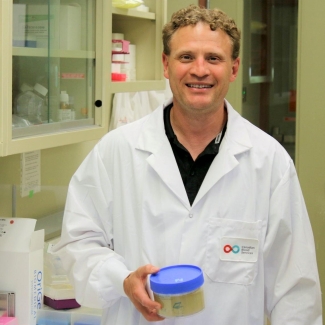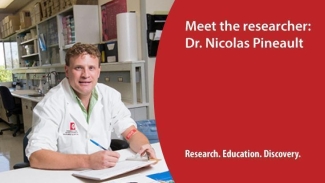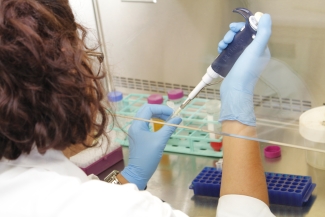I’m fascinated by the power of stem cells: Q&A with Dr. Nicolas Pineault
Friday, July 19, 2019 Obinna Okwelume
For more than two decades, Dr. Nicolas Pineault has worked in stem cell biology. Since joining Canadian Blood Services in 2012 as a development scientist at the Centre for Innovation, he has conducted research in stem cells from cord blood, bone marrow cells and platelets. Dr. Pineault is an adjunct professor at the University of Ottawa (uOttawa).
Because July is Cord Blood Awareness Month, we talked to Dr. Pineault about his ongoing research in cord blood, as well as his passions and other new projects.
Q. Tell us about yourself and the work you’re currently engaged in.
A. I've been working in the field of stem cell biology since my PhD studies, which I did at the University of British Columbia from 1995-2001. Before joining Canadian Blood Services in 2012, I was a research scientist in the research and development division at Héma-Québec. My other passions in life are hockey, sports, camping and spending time with my family.
At Canadian Blood Services, I oversee two areas of development and research. First, together with my senior research assistant Roya Pasha, I support the operation of the stem cell manufacturing branch of the organization, including the public cord blood bank located here in Ottawa. We also provide technical and knowledge support. For instance, we developed a thaw protocol for cord blood units distributed by Canadian Blood Services, and optimized various processes used in the stem cell manufacturing business.
My second area of research is studying the impact that stem cell expansion has on the capacity of cord blood stem cells to support engraftment. This research occurs here in our lab at head office and at the animal facility of uOttawa, and is mainly conducted by the graduate students, honour students and post-doctoral fellows whom I supervise and support.
Q. What are the biggest challenges that currently exist in cord blood research?
A. Two areas of work are very popular in the field of cord blood hematopoietic research. The first area is improving the engraftment activity of cord blood to lead to faster recovery of transplant patients. This is done either by tricking stem cells to move to the bone more efficiently after transplant, or by expanding stem cells so that more cells are available for transplantation. Our lab does a lot of research in these areas. Another exciting area of work is gene editing, which could one day provide a long-term cure for patients with common hemoglobinopathies such as sickle cell anemia and beta-thalassemia. This approach tries to genetically correct point-mutations in the DNA of the patients’ stem cells so that their progeny-like red cells can produce normal red cells.
Q. How do you see the role of your research in improving outcomes for Canadian patients?
A. Stem cell transplantation is used to cure over 80 diseases, including leukemia and immunodeficiencies, and new exciting possibilities are emerging that may cure other diseases or disorders such as autism and cerebral palsy. So, our work focuses on maximising the quality of stem cell products processed and produced at the Canadian Blood Services to improve outcomes of stem cell transplant for Canadian patients.
Q. What’s your next project?
A. We're currently working on a project for the stem cell manufacturing lab in Ottawa about donor-lymphocyte infusion, or DLI products. The objective of this project is to demonstrate that the DLI product retains its quality attributes following changes in production requested by The Ottawa Hospital, namely freezing smaller volumes in new bags. In my wish list, I would love to bring in and optimize the technology that can be used to correct sickle-cell mutation in hematopoietic stem cells. This disease is one of the most common genetic disorders in humans, and current treatment options are not curative.
Q. Why do you care about your work?
A. I never thought as an undergrad student in biochemistry at Laval University that I would one day work in the field of stem cell biology. This changed after I did my first immunology course and spent a summer internship at the R&D department of the Red Cross in Quebec City. Since then, I have always been fascinated and impressed by the power of stem cells, and by the incredible research that surrounds these special cells. This is one of the passions that fuels my energy for my line of work.

Canadian Blood Services – Driving world-class innovation
Through discovery, development and applied research, Canadian Blood Services drives world-class innovation in blood transfusion, cellular therapy and transplantation—bringing clarity and insight to an increasingly complex healthcare future. Our dedicated research team and extended network of partners engage in exploratory and applied research to create new knowledge, inform and enhance best practices, contribute to the development of new services and technologies, and build capacity through training and collaboration. Find out more about our research impact.
The opinions reflected in this post are those of the author and do not necessarily reflect the opinions of Canadian Blood Services nor do they reflect the views of Health Canada or any other funding agency.
Related blog posts
Dr. Pineault and his team are working on a cellular therapy to improve engraftment (the process through which new blood-forming cells start to develop in the patient) following cord blood stem cell transplantation.
Kudos to our research colleagues at The Ottawa Hospital on receiving 18 new CIHR research grants worth $10.7 million.
July marks Cord Blood Awareness Month in certain places around the world. In homage to this important campaign we collected a few related stories from the RED archives and share a bit more information about why Cord Blood matters. Cord blood stem cells can be used in the treatment of more than 80...


